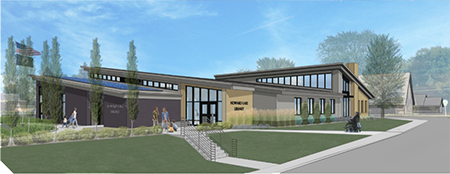Howard Lake Set to Open State’s First Net-Zero Library
By Heather Rule
Howard Lake ran the risk of losing its library.
A Great River Regional Library System largescale assessment found that Howard Lake was the smallest, most outdated, and most under-used library in its system. To stay an active member, Howard Lake needed to consider upgrading.
“The old library just wasn’t going to cut it anymore,” said Sue Claessen, secretary/treasurer of Howard Lake’s Friends of the Library.
The Howard Lake City Council and City Administrator Nick Haggenmiller, along with support from the Friends of the Library, worked on solutions. The result is a new, net-zero library building that counterbalances the amount of greenhouse gas emissions produced by the facility with the amount removed from the atmosphere. It’s the first net-zero library in Minnesota.
Ground broke in August 2023 for the new 7,000-square-foot library in the center of town, with an expected opening in June 2024.
Background and planning process
Discussions for the new library started in 2017 after the library system assessment and a feasibility study was conducted that explored various options. However, the “real meat and potatoes” of new library construction didn’t start until 2021, Haggenmiller said.
The city of about 2,500 people was deliberate in engaging the community with open houses and surveys, and giving the Friends of the Library a seat at the table to consider the overall needs of library programming in the space.
The new building will only be about 1,000 square feet bigger than the current library, built in 1979 during the energy crisis. The old building was built into a hillside with almost no windows. Haggenmiller called it a “concrete fortress.” Ninety-nine percent of the library’s services are currently in a space “about the size of a two-stall garage,” Haggenmiller said.
New amenities and features

The new building will have high-efficiency windows, solar panels, and heating, ventilating, and air conditioning systems “miles above” a typical high-efficiency system, Haggenmiller said. A lot of windows allowing natural light for passive solar energy will be one noticeable difference for library users.
“When you think about it, libraries are designed for the future,” Claessen said. “This one, I’m sure, will take us into the next 40 or 50 years.”
What library patrons will perhaps take notice of, too, is the way space will be used inside the new building. Currently, space is so tight that the children’s story area overlaps with a space for adults reading newspapers or using computers.
The one-level, new library will provide more separation and breathing room with areas for children and teenagers, along with a full circulation of books. There will also be a meeting room for community use.
“I’m excited about the space,” Claessen said. “And it’s just going to be configured so much more usably this time.”
A net-zero facility
Building a net-zero library was not part of the initial project planning conversations, Haggenmiller said. However, to meet the requirements for a Minnesota Department of Education grant, which helped finance the $5.6 million project, the building would need to meet the state’s B3 energy guidelines. Learning that the new building’s design could accommodate a lot of solar panels is what advanced discussions and ultimately the decision to move beyond meeting the B3 energy guidelines to instead creating a net-zero facility.
It came down to a long-term cost-benefit and having the net-zero benefits in place for the future, according to Haggenmiller.
“Just a very pragmatic response to what seems like a pretty green initiative was met with favoritism by the Council, by the community, because this makes both mental sense and financial sense,” Haggenmiller said.
To the best of Haggenmiller’s knowledge, Howard Lake will house the first net-zero library in the state. It’s hard to know for sure, without a database or list of net-zero libraries around the country, but it’s also believed to be the first net-zero library in the upper Midwest.
“I think the single biggest takeaway is that if this tiny little town of Howard Lake can do it, any other city in the state or even the country can do it as well,” Haggenmiller said.
What he called a “secret sauce” in the process, however, was navigating through the hoops and bureaucracy within the various funding mechanisms for the project. Communities should be aware of requirements or construction procedures that are attached to various funding sources, according to Haggenmiller.
“We jumped in really cautiously, and we’re learning as we go,” he said.
Claessen encourages other cities or organizations not to be deterred if they’re a small entity, thinking that net-zero might not work for them. As with any construction project, stay determined, she said.
“If this is something that feels right for your community, keep looking,” Claessen said. “Because there should hopefully be a way to do this.”
Heather Rule is a freelance writer.

